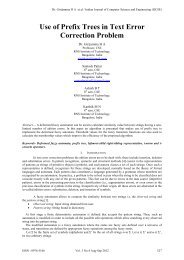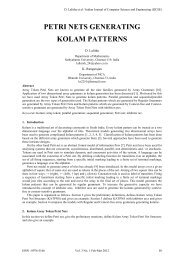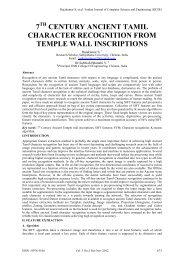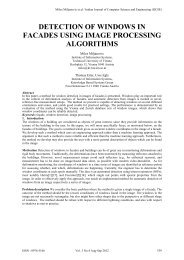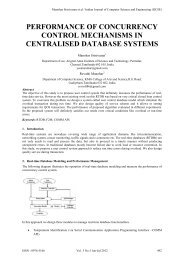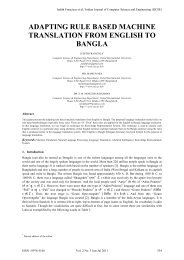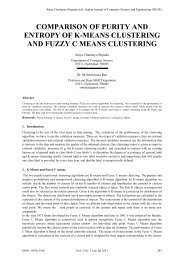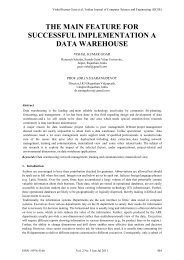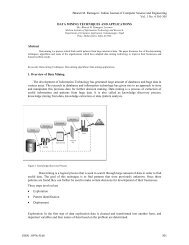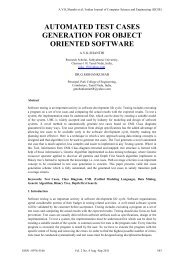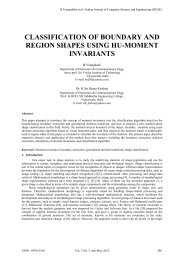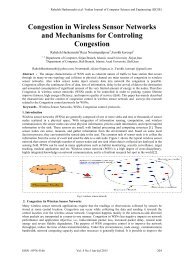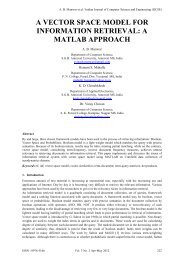fuzzy logic application in power system fault diagnosis
fuzzy logic application in power system fault diagnosis
fuzzy logic application in power system fault diagnosis
Create successful ePaper yourself
Turn your PDF publications into a flip-book with our unique Google optimized e-Paper software.
Krisna Kant Gautam et al./ Indian Journal of Computer Science and Eng<strong>in</strong>eer<strong>in</strong>g (IJCSE)--------- (1)-----------(2)---------(3)where Ci is one of the possible <strong>fault</strong> sections be<strong>in</strong>g considered; P<strong>fault</strong> is the <strong>fuzzy</strong> set which conta<strong>in</strong> all thepossible <strong>fault</strong> sections and their membership functions; Fi(CB) is the <strong>fuzzy</strong> subset by consider<strong>in</strong>g only thetripped circuit breakers; Fi(RL) is the <strong>fuzzy</strong> subset by consider<strong>in</strong>g only the operated relays.5.5. ConclusionGenerally, a conventional rule-based expert <strong>system</strong> for bulk <strong>power</strong> <strong>system</strong> needs several hundreds of rules. It istime consum<strong>in</strong>g <strong>in</strong> <strong>in</strong>ference procedures to search for suitable rules dur<strong>in</strong>g <strong>in</strong>ferenc<strong>in</strong>g. On the other hand, <strong>fuzzy</strong>set based expert <strong>system</strong>s tend to be much faster compared to traditional rule-based expert <strong>system</strong>s for most ofthe rules are replaced by the calculation of the membership functions of the applicable rules . Only a few rulesor functions are used <strong>in</strong> the <strong>in</strong>ference eng<strong>in</strong>e. The <strong>fuzzy</strong> set approach for uncerta<strong>in</strong>ty process<strong>in</strong>g <strong>in</strong> expert<strong>system</strong>s offers many advantages to compared other approaches to deal with uncerta<strong>in</strong>ty.Small memory space and computer time: The knowledge base is very small because there are only a few rulesneeded dur<strong>in</strong>g <strong>in</strong>ference. The computationtime is therefore also small.o Small number of rules: With properly designed l<strong>in</strong>guistic variables and level of granularity,only a few <strong>fuzzy</strong> rules are needed for each situation.o Flexibility of the <strong>system</strong>: Membership functions represent<strong>in</strong>g the parameters can be changeddynamically accord<strong>in</strong>g to the situation. It is also possible to develop a self-learn<strong>in</strong>g modulethat modifies the grades of membership automatically accord<strong>in</strong>g to chang<strong>in</strong>g situations.5.6 References[1] T. S. Dillon and M. A. Laughton, Expert System Applications <strong>in</strong> Power Systems, Prentice Hall International Series <strong>in</strong> Power SystemsComputation.[2] N. Vadiee and M. Jamshidi, “The Promis<strong>in</strong>g Future of Fuzzy Logic,” IEEE Expert, August 1994, pg. 37.[3] R. Levi, M. Rivers and K. Hickey, “An Intelligent Instrument for High Voltage Equipment Insulation Evaluation,” Proceed<strong>in</strong>gs of the1994 International Conference on Intelligent System Application to Power Systems, France, Sept.[4] 1994, pp. 471-476.[5] S.C. Shapiro, ed., Encyclopedia of Artificial Intelligence, Wiley, New York, 1992.[6] Yuan-Yih Hsu, F. C. Lu, Y. Chien, et al., “An expert <strong>system</strong> for locat<strong>in</strong>g distribution <strong>system</strong> <strong>fault</strong>s,” IEEE Trans. on[7] PWRD, Vol. 5, No. 2, pp366-371.[8] M. Kezunovic, C. W. Fromen, et al., “An expert <strong>system</strong> for transmission substation event analysis,” IEEE Trans. on Power Delivery,Vol.8, No. 4, Oct. 1993, pp1942-1949.[9] J.R. McDonald, G.M.Burt D.J. Young, “Alarm process<strong>in</strong>g and <strong>fault</strong> <strong>diagnosis</strong> us<strong>in</strong>g knowledge based <strong>system</strong>s for[10] transmission and distribution network control,” IEEE Trans. on Power Systems, Vol.7, No.3, Aug. 1992, pp1292-1298.[11] Takafumi Kimura, S<strong>in</strong>ya Nishimatsu, et al., “Development of an expert <strong>system</strong> for estimat<strong>in</strong>g <strong>fault</strong> section <strong>in</strong> control center based onprotective <strong>system</strong> simulation,” IEEE Trans. On Power Delivery, Vol.7, No.1, Jan., 1992, pp167-172.[12] C.A. Protopapas, A.V. Machias, et al., “An expert <strong>system</strong> for substation <strong>fault</strong> <strong>diagnosis</strong> and alarm process<strong>in</strong>g,” IEEE Trans. on PowerDelivery, Vol.6, No.2, April 1991, pp648-655.[13] Benoit Valiquette, Germano Lambert Torres, “An expert <strong>system</strong> based <strong>diagnosis</strong> and advisor tool for teach<strong>in</strong>g <strong>power</strong>[14] <strong>system</strong> operation emergency control strategies,” IEEE Trans. on Power Systems, Vol.6, No.3, Aug. 1991, pp1315-1322.[15] Chihiro Fukui, Junzo Kawakami, “An expert <strong>system</strong> for <strong>fault</strong> section estimation us<strong>in</strong>g <strong>in</strong>formation from protective relays and circuitbreakers,” IEEE Trans. on Power Delivery, Vol. PWRD-1, No.4, Oct. 1986.[16] C.S Chang, J.M. Chen et al., “Power <strong>system</strong> <strong>fault</strong> <strong>diagnosis</strong> us<strong>in</strong>g <strong>fuzzy</strong> sets for uncerta<strong>in</strong>ties process<strong>in</strong>g,” accepted for[17] publication <strong>in</strong> ISAP’96, Orlando, USA.[18] C.S. Chang, J.M. Chen, A. C. Liew, “An expert <strong>system</strong> approach for <strong>fault</strong> <strong>diagnosis</strong> consider<strong>in</strong>g uncerta<strong>in</strong>ties,” Proceed<strong>in</strong>gs ofInternational Conference on Intelligent Manufacture<strong>in</strong>g’95 (ICIM’95), Wuhan, Ch<strong>in</strong>a, June, 1995.[19] Cho H.J., Park J. K., Lee H. J., “A <strong>fuzzy</strong> expert <strong>system</strong> for <strong>fault</strong> <strong>diagnosis</strong> of <strong>power</strong> <strong>system</strong>s,” Proceed<strong>in</strong>gs of ISAP’94, Montpellier,France, Sept., 1994, pp217-222.[20] P. Jarventausta, P. Verho, J. Partanen, “Us<strong>in</strong>g <strong>fuzzy</strong> sets to model the uncerta<strong>in</strong>ty <strong>in</strong> the <strong>fault</strong> location process of[21] distribution networks,” IEEE Trans. on Power Delivery, Vol.9, No. 2, April 1994, pp954-960.[22] Zhu Yongli, Y.H. Yang, B. W. Hogg, W.Q. Zhang, S. Gao, “An expert <strong>system</strong> for <strong>power</strong> <strong>system</strong>s <strong>fault</strong> analysis,” IEEE[23] Trans. on Power Systems, Vol. 9, No. 1, Feb., 1994, pp503- 509.[24] Fushan Wen and Zhenxiang Han, “Optimal <strong>fault</strong> section estimation <strong>in</strong> <strong>power</strong> <strong>system</strong>s us<strong>in</strong>g a genetic algorithm,”[25] accepted for Journal of Electric Power Systems Research.ISSN : 0976-5166 Vol. 2 No. 4 Aug -Sep 2011 558



